The Future of the Human Landscape
Air Date: Week of January 8, 2010
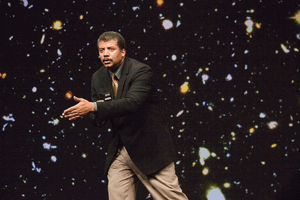
Neil DeGrasse Tyson warns that the Apophis asteroid is heading towards us. (Photo by Greyhawk68)
Host Jeff Young examines some of the changes humans will experience by 2020. Linguist David Harrison says the diversity of human expression is under threat. Indeed, “we are losing a language every two weeks.” But Erin McKean, the former editor of the Oxford American Dictionary, sees words evolving ever faster, meaning the dictionary, in book form, is bound to change. Architectural advisor Rachel Armstrong says new technologies will transform our homes into living, moving, climate- adapting structures.
Transcript
[CHILDREN SINGING]
YOUNG: It’s not just biological diversity that’s at risk – we’re also losing diversity of human expression – this could be one of the last times we hear sounds like this: the Chamacoco language of Paraguay.
HARRISON: We are losing languages at a very rapid pace, some people have estimated as frequently as a language every two weeks or so. This trend is going to continue into the next decade.
YOUNG: Tapping high tech to save indigenous languages. That’s just ahead on Living on Earth – stay tuned.
YOUNG: It’s Living on Earth, I’m Jeff Young and we’re looking ahead to the coming decade. Hundreds of native languages are expected to die by 2020 – unless David Harrison of the Living Tongues Institute has his way.
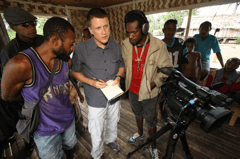
Dr. David Harrison works with John Agid (left) of Matugar village, Papua New Guinea, to record the endangered Panau language. (Photo: Chris Rainier)
HARRISON: I feel a great sense of responsibility when I am sitting at the foot of an elder. I want to hear every single word that they are prepared to share with me. And I want to listen very attentively to record it, to understand it, and often even the people in their own household or their neighbors don’t recognize or even known that they happen to know this ancestral language.
So, what you get is a few elderly speakers scattered across different locations. I’m able to create new situations for them. I actually transport elders from one village to the other, and they just love it. They just start talking – they even forget that I’m there, that I’ve got a camera and a recording device. For example, our last speakers of Chulym in Siberia. And the Chulym language is highly likely to go extinct within the coming decade. I can play a little sound clip for you of some conversation in Chulym among some of the very last elders:
[ELDERS SPEAKING CHULYM]
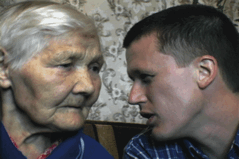
Chulym-speaker Nina Tarlagonova and Dr. David Harrison in a still shot from The Linguists. (Courtesy of Ironbound Films, Inc.)
HARRISON: One of the projects that I’ve been working on with the Living Tongues Institute is to help some of these small languages cross the digital divide and to bring them over into high tech domains, so that the members of the community can say, oh well of course my language is suitable for text messaging or can be posted on social networking site; it’s just as good as any other language. I can use it in all these domains.
And I’ve created a suite of talking dictionaries for some small and not very well-represented languages. I’m right now in the process of turning the talking dictionary into an iPhone application. So, you would actually be able to have your iPhone and to download and play and listen to sound files from very small languages that are maybe endangered or may not be very well represented in cyberspace yet, but they will be. And this is really the key. And these languages, once they have that opportunity, once the door is open to them to enter into high tech domains, of course they will adapt. They will develop all of the little shortcuts that we have in English, the sort of “LOL” text messaging abbreviations and things. They will adapt perfectly because adapting to new circumstances is really what languages do best. It’s not an inevitability. Small languages do not have to be extinct. They don’t have to be oppressed out of existence. There’s room in the world, there’s room in the human intellect for a diversity of languages.
YOUNG: Living Tongues Institute Director David Harrison. Technology will continue to shape our tongue in the coming decade, too, bringing radical change to that ultimate arbiter of the English language – the dictionary. Lexicographer Erin McKean once edited the New Oxford American Dictionary. Now, she’s working to close the book on dictionaries, as we know them.
MCKEAN: Oh totally, but I think that the book shape is the wrong shape for the dictionary. I don’t know if you cook very much, if you’re from the South you may have actually cooked with Crisco. But at some point in the recent past you started being able to get Crisco in sticks. I think that Crisco in a stick is one of the triumphs of modern civilization. Because it’s so much easier to cook with. The tub is the wrong shape for Crisco because you get it all over your hands; it’s really hard to measure.
YOUNG: That’s true.
MCKEAN: In the same way the book is the wrong shape for the dictionary because it’s too small, it can’t hold all the words. It can’t even hold all the right kinds of information about the words that it does hold. It doesn’t tell you anything about people’s opinions about a word. It doesn’t tell you people think this word is beautiful. It doesn’t tell you, oh, this adjective is only used with these objects. It doesn’t tell you words work, it only tells you what words mean, and what words mean is just one facet of how words work.
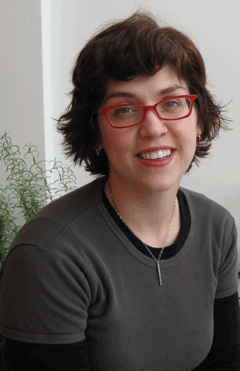
Lexicographer Erin Mckean.
YOUNG: So, the way we use a dictionary is clearly going to change. Is the content of the dictionary going to change a lot, as well? What’s going to get in?
MCKEAN: Every single word, or phrase, or idiom, or combination. The only reason that some things are in a dictionary right now and some things aren’t is that the print book is just too small to hold every word of English. Even the Oxford English Dictionary has fewer than a million words in it, and it’s pretty easy without even doing a whole lot of heavy lifting to find more than, say, four million unique English words.
YOUNG: You got to draw the line somewhere. If I just say “squizzlebop” is that going to be a word?
MCKEAN: If you use it as a word, it’s a word. It’s all about intent and communicative value.
YOUNG: This is anarchy! This is anarchy!
MCKEAN: [Laughs] No, it’s not! Just because a word is a word, doesn’t mean it’s a good word. And so part of the job of the dictionary is to let you know, most people think this word is terrible, so maybe you don’t want to use it. A lot of people feel that if a word’s in the dictionary it’s perfectly okay to use, and if it’s not in the dictionary it’s perfectly not okay to use it. And this is not a very good system for making word decisions because the dictionary is on a time lag, especially print dictionaries, and because there may be words that are perfectly, let’s say cromulent in certain contexts that are not okay in other contexts.
YOUNG: Cromulent? Excuse me; I have to go to a dictionary.
MCKEAN: [Laughs] That’s a word you may not find in the dictionary because it’s from an episode of “The Simpsons”. And cromulent means “okay” and it was actually used when one of the teachers in Bart’s school was saying to another teacher, you know, I can’t believe you don’t know that word – it’s a perfectly cromulent word.
[YOUNG laughs]
MCKEAN: But once it was used in “The Simpsons” it became a word, automatically.
YOUNG: Uh huh. Well, will emoticons ever make it into the dictionary? Please say no.
MCKEAN: [Laughs] I’m going to have to disappoint you.
[YOUNG groans]
MCKEAN: Well, okay, but think about this: the exclamation point, if you really think about it, is a kind of emoticon.
YOUNG: Hmm.
MCKEAN: It’s an image that tells you what kind of expression goes with the sentence. I mean think of the difference between saying, “It’s on fire” period, and “It’s on fire” exclamation point.
YOUNG: Is there any place at which I can make you draw the line and say, “No, sorry that’s just not acceptable – that’s not a word.”
MCKEAN: People have tried. [Laughs] But the truth is that I’m not the person who decides what’s a word and what’s not a word. If you use something as a word, there’s a little magic an alchemy that happens that makes that a word.
YOUNG: But you’re writing dictionaries! Isn’t that your job?
MCKEAN: My job is to map the language. So, I tell you where everything is, and what it is. But I don’t leave the red-light district off the map because I disapprove of it.
YOUNG: Mm hmm.
MCKEAN: That would make a pretty bad map. And then you’d stumble into the red-light district and not know where the heck you were. And that wouldn’t help anybody.
YOUNG: Are we headed toward something better than a word?
MCKEAN: In my opinion there is nothing better than words. Even if they invented some magical telepathy device or something that let us convey emotion through perfume or anything else. Nothing is better than words. And that is possibly my not inconsiderable bias talking.
YOUNG: Erin McKean, lexicographer and now CEO of a new online dictionary, called Wordnik. Thanks very much.
MCKEAN: You’re very welcome.
[MUSIC: Laurie Anderson’s “Language is a Virus”]
YOUNG: And now, from living languages of the coming decade to living buildings.
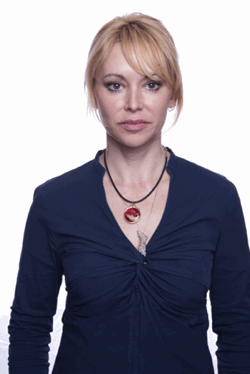
Rachel Armstrong is a Senior TED Fellow who advises architects on the protocell system. (Photo provided by Rachel Armstrong)
ARMSTRONG: I’m Rachel Armstrong. I advise architects on how to incorporate biological systems into their design work. My work at the moment involves a system called the protocell.
Protocells are self-assembling, autonomous, very primitive chemical systems that have some of the properties of living systems, but are not strictly speaking alive. They are capable of life-like processes such as growth, movement, sensitivity and I think these protocells are going to be incredibly important for us in the next ten years or so, in that we will develop materials that we can put on the outside of buildings that can take carbon dioxide from a carbon-rich air that we produce in the cities and around our homes and factories, and then we’ll trap the carbon dioxide and fix it as a solid material on the outside of the buildings and we will see our buildings transformed by these materials that are carbon fixing. This is going to give quite interesting appearance to a community of houses, so down your street now.
[MUSIC: The Books “Future, Wouldn’t That Be Nice]
ARMSTRONG: All the buildings have got this biolime, let’s call it, on the outside of the buildings. It’s gradually growing and you can see little stalactites and stalagmites – little spicules of limestone that has managed to stray away from the outside of your home. And maybe there’s a source of carbon emissions, maybe somebody’s got a dirty chimney down the road and the biolime will actually start making its way toward that source of nutrients because it would regard carbon emissions as being something that it would like to engage with and turn it into a crystal. And so, you could start to imagine two buildings would snuggle up together and they will lose the space between them. It’ll be a bit like cloud watching, where we will start to see different characters in different houses. So, maybe some houses will look like a giant goblin, others would look more like a sleeping cat.
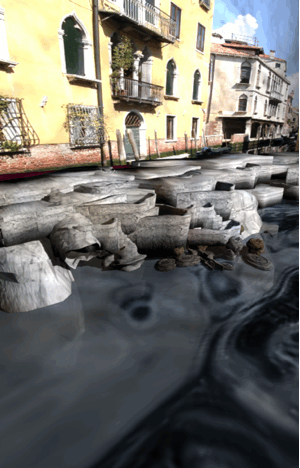
An a artificial limestone reef growing under Venice just might save the historic city. (Photo: Christian Kerrigan)
[MUSIC CONTINUES]
ARMSTRONG: So, these technologies will be quite visible and there’s a real reason for this, and I think this is an important reason that at the moment it’s very hard to get any kind of handle on how we are affecting our environment by the production of carbon emissions; we can’t see carbon dioxide. But when we actually are able to see it in a material way, growing on the outside of our houses, we can actually start to have a personal relationship with carbon dioxide levels. We can see that maybe one-year the growth of the houses is much thicker than another year, a bit like the rings in the bark of a tree. The protocells will become more autonomous as we develop the science that’s underpinning them. It’s predicted that in the next ten years, that protocells may actually be able to self-regulate and divide.
[MUSIC CONTINUES]
ARMSTRONG: The way I think that these completely challenge our understanding of technology is that at the moment we consider technologies to be things that we can control at the push of a button. I think the 21st century is going to give rise to technologies that we don’t control by subordination, by annihilation through antibiotics and antiseptics. What we need to do in order to get the best out of these technologies is to become engaged with them. So that we interact with them, we monitor them, and we live with them; we live along side them, just like all the other species on the planet. We blossom when we’re in complex ecologies and I think that synthetic ecologies and synthetic organisms are going to be an important part of that integrated balance that we should attain if we are able to behave in a more responsible and grown up manner towards all living forms on the planet.
YOUNG: Architectural advisor, Rachel Armstrong.
[MUSIC: The Books “There Is No There]
YOUNG: Well, we’ve heard a lot about problems we’ll face on our planet in the coming decade – many of them of our own making. But astronomer Neil DeGrasse Tyson says we’ll also need to keep an eye on the sky. Tyson directs the Hayden Planetarium at the American Museum of Natural History in New York, where, among other things, he keeps watch on an asteroid called Apophis.
TYSON: You know the solar system’s a shooting gallery. And Earth, many people don’t know, plows through several hundred tons of meteors a day. So, the range of these that could hit us is huge.
[SOUNDS OF SCI-FI SPACE]
The 1998 film Deep Impact dramatizes what an Apophis tsunami might look like.
TYSON: Apophis – that was discovered in December 2004. It’s an asteroid about the size of the Rose Bowl. If the Rose Bowl – imagine that as kind of like an eggcup, and you place something in it to hold it, that’s about how big that asteroid is. That’s not too shabby – that one, if it hits, it’ll do some serious damage.
[SCI-FI SOUNDS: “And it’s going to strike the Earth in six days.”]
TYSON: The first calculation showed that there was a real chance it could hit Earth in the year 2029 on April 13th. Which, by the way, happens to be a Friday. No one read about this because coincidentally over that same week we had the tsunami in Indonesia and so that rightly got the headlines given the death toll that that exacted. What’s intriguing, however, is that if this thing hits Earth, the current trajectories show it would hit the Pacific, if it hits the Earth at all, and that would create a tsunami on the West coast that would dwarf anything that happened in Indonesia.

Neil DeGrasse Tyson warns that the Apophis asteroid is heading towards us. (Photo by Greyhawk68)
After better orbit was calculated because once you discover something you have a few data points and there’s huge uncertainties if you only have a few observations. As the months went by we had better orbital data and we determined that no, it will not hit us April 13th 2029, but it will come very close. It will come closer than Earth’s orbiting communication satellites. It’ll be the biggest, closest thing we’ve ever seen in the history of history. It’d be visible from northern Europe and it’s basically – think of it as a shot across our bow. The universe saying, “I’ll miss you this time, but I’ll give you another chance to try to deflect me.”
Depending on its actual trajectory on that pass we will learn whether it will hit us April 13th, 2036 – we’re on a seven-year intersection orbit.
Our orbit, plus the orbit of that one, intersects every seven years. Currently, the best estimate is several in a million that it will hit us. And you say, “Ahhh, let’s not worry.” Well, if it hits us it could do a trillion dollars worth of damage, and so several in a million you get some insurance people they can calculate how much – what kind of insurance you want to take out given what kind of risk that represents. And it means you should be doing something.
[SCI-FI RECORDING: “But how can the entire world prepare for the ultimate disaster?”]
TYSON: Oh, so you want to protect the Earth and you realize, in fact, that everybody has to agree to do this, and…yes, that’s a whole other level of international cooperation. So, if an asteroid’s going to come and render Earth extinct, then petty differences among people chosen for completely arbitrary reasons of what god you worship, or what skin color you are, or what line in the sand separates your property that all that pales compared to the prospect of going extinct.
So, yes, we would need international cooperation. What many people, we have top sort of engineers and dynamicists working on – one problem, which is – involves what we call a gravitational tractor. A kind of a tractor beam where you send up a spaceship, bring it close to the asteroid, but not touch it, and you sort of park it there. And what I mean by – both of these are moving through space so when I say park, I mean you match velocities with the asteroid. And their mutual gravity will want to attract them to each other. And as they drift, you say, no, I’m not going to let that happen. So, you put on the little retro rockets on the rocket to prevent them from colliding. The act of doing that effectively tugs the asteroid out of harm’s way. Because all you really want to do is move it so that it will not hit Earth in its trajectory. It’ll still be out there, its orbit will still cross the orbit of the Earth, but you’ve lived to enjoy another day.
[MUSIC]
TYSON: That’s really the way to do it. So, it’s a matter of how much do you want to protect the Earth, really what it comes down to.
YOUNG: Astronomer Neil DeGrasse Tyson directs the Hayden Planetarium at the American Museum of Natural History in New York. You can hear more from him and many of the other big thinkers in today’s show – and take a trip through the past decade with an interactive timeline – it’s all at our website, LOE dot org.
Links
To hear Erin's TED talk, "Erin McKean redefines the dictionary," click here.
Visit Wordnik, Erin Mckean's online dictionary
To hear a longer interview with David Harrison click here
To hear a longer interview with Erin McKean click here
Click here to hear Neil de Grasse Tyson on alien intelligent life
Click here to hear Neil de Grasse Tyson on the future of space exploration
Living on Earth wants to hear from you!
Living on Earth
62 Calef Highway, Suite 212
Lee, NH 03861
Telephone: 617-287-4121
E-mail: comments@loe.org
Newsletter [Click here]
Donate to Living on Earth!
Living on Earth is an independent media program and relies entirely on contributions from listeners and institutions supporting public service. Please donate now to preserve an independent environmental voice.
NewsletterLiving on Earth offers a weekly delivery of the show's rundown to your mailbox. Sign up for our newsletter today!
 Sailors For The Sea: Be the change you want to sea.
Sailors For The Sea: Be the change you want to sea.
 The Grantham Foundation for the Protection of the Environment: Committed to protecting and improving the health of the global environment.
The Grantham Foundation for the Protection of the Environment: Committed to protecting and improving the health of the global environment.
 Contribute to Living on Earth and receive, as our gift to you, an archival print of one of Mark Seth Lender's extraordinary wildlife photographs. Follow the link to see Mark's current collection of photographs.
Contribute to Living on Earth and receive, as our gift to you, an archival print of one of Mark Seth Lender's extraordinary wildlife photographs. Follow the link to see Mark's current collection of photographs.
 Buy a signed copy of Mark Seth Lender's book Smeagull the Seagull & support Living on Earth
Buy a signed copy of Mark Seth Lender's book Smeagull the Seagull & support Living on Earth

